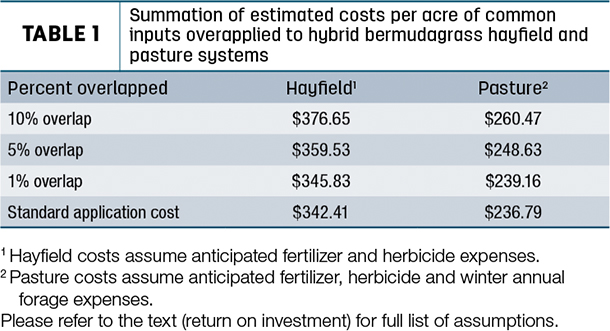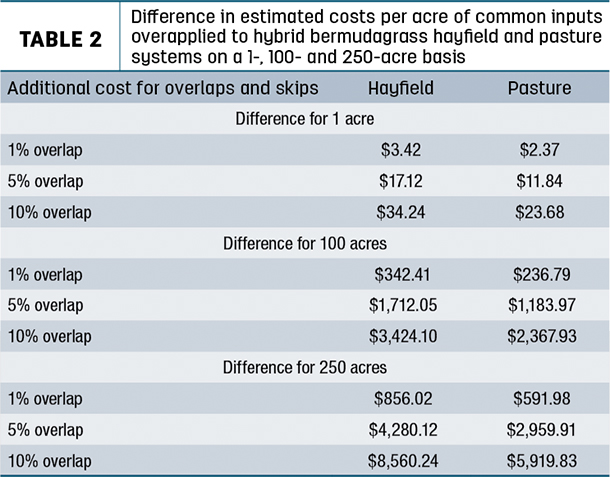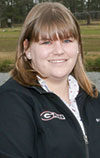As more agriculture technology comes onto the market, there is a clear need to integrate foundational management practices with new precision technologies. Precision technologies can include anything from tractors with autosteer to soil moisture sensors to variable-rate fertilizer or seeding.
Why use GPS guidance in forage operations?
As more agriculture technology comes onto the market, there is a clear need to integrate foundational management practices with new precision technologies.
At the University of Georgia Hay and Baleage short course held in March 2020, 75% of attendees did not currently use precision technology on their own farms, but were interested in learning more. Precision technologies can include anything from tractors with autosteer to soil moisture sensors to variable-rate fertilizer or seeding.
Some of the most widely adopted precision technologies include guidance systems that utilize a global positioning system (GPS). These technologies are commonly utilized in row-crop agricultural systems but also have many potential benefits in forage-based production systems.
Guidance systems can be used in pastures or hayfields to apply fertilizer or herbicides more effectively, avoid skips and overlap when planting, or track driving paths on harvesting equipment.
Equipment operators often rely on tire tracks or soil disturbances to determine the next pass, but this can be a challenge when performing routine tasks such as applying lime or planting with a no-till drill. This may translate to skips or over application of the product. Guidance aids help maintain pass-to-pass distance, which results in fewer total passes and increased field efficiency.
This can ultimately result in more efficient management of crop inputs including time, fuel, chemicals and seed. Furthermore, guidance aids can help in reducing driver fatigue, thus allowing the operator to focus more on other machine functions and in-field equipment performance.
What types of guidance aids are available?
With so many different options to choose from, it can be difficult to determine which technologies are the best fit for your farm and budget. A light bar system is an excellent choice for an entry-level guidance option because it is low-cost technology that offers many advantages to forage operations. The list below gives other guidance options from basic to advanced, with information about each type of system.
1. Smartphone/tablet applications for manual steering
Most of these applications are free; however, they are significantly less accurate than other options listed in this article because they rely on cellular service and have a slower update rate during operations. These GPS systems are not designed to be accurate or repeatable to the level required for most agriculture work and therefore are not often recommended.
2. Manual steering aids (light bar systems)
These systems provide a virtual guidance line to follow and provide instant feedback to the operator on real-time equipment position in the field, as well as on how far off and in which direction equipment is from the actual guidance line. The light bar guidance system has been around for almost 30 years and is very simple to set up and use. Most light bar systems include a differential GPS (DGPS) or GPS augmentation receiver and antenna, some sort of computer or microprocessor, and a light bar or graphics display.
However, please note that these systems still require manual steering. There are many variations in light bar displays. Some have a single row of lights, while others may have two rows of lights and some systems even have LCD displays with 2D and 3D representations of the field and guidance paths.
3. Automatic steering aids
Autosteer systems come in many different forms and levels of accuracy, from retrofit systems that clamp onto the steering wheel or steering column, to systems installed at the factory level that fully control the hydraulic or electric steering on the tractor. The cost of these systems can be much greater than a light bar. It can be difficult to justify adopting higher cost and accuracy guidance aids, especially in low-input forage production systems, as they may not have the return on investment as when used in higher-value crops (i.e., peanuts). While automatic guidance systems may not be beneficial in pasture-based systems utilized for grazing, they can be of significant benefit in high-quality hay operations.
What is my expected return on investment?
The typical price for new light bars can be from around $400 to $2,000, depending on the features and accuracy desired by an operator. While this seems like a large range for a guidance aid, remember that the lower end of the price range will be a light bar that just has a single row of LED lights and a wide area augmentation system (WAAS)- compatible GPS.
In addition to the cost of the system, the cost of misapplication either via skips or overlaps can be a major issue in forage production. The calculations considered here encompass common forage management practices typically applied to a hybrid bermudagrass pasture or hayfield annually. These calculations do not account for fixed costs (i.e., equipment) or variable costs related to application of the products (or additional products, such as insecticides).
The average cost per acre was calculated at $342.41 and $236.79 for a hayfield and pasture, respectively. We assumed fertilizer at 300 pounds nitrogen (N), 60 pounds phosphorus pentoxide (P2O5) and 250 pounds potassium oxide (K2O) per acre for hayfields and 200 pounds N, 30 pounds P2O5 and 120 pounds K2O per acre for pastures.
For the hayfield scenarios, we assumed indaziflam was applied at 6 ounces total per acre per year, nicosulfuron plus metsulfuron at 1.5 ounces per acre per year and aminopyralid plus 2,4-D at 20 ounces per acre per year.
For the pasture scenarios, we assumed aminopyralid plus 2,4-D was applied at 20 ounces per acre per year. Since the majority of livestock producers will overseed their bermudagrass pastures with a winter annual forage to extend the grazing season, we assumed rye was planted at 90 pounds of pure live seed per acre and was fertilized with 100 pounds N per acre.
As expected, costs increase as overlaps increase because of over application of fertilizer, herbicide and seed inputs (Table 1).

This difference is likely much larger if you consider application costs, such as the amount of time spent applying and number of passes across the field. Although not presented here, you would expect costs to decrease as skipped areas increase. While cost estimates decrease, it should be realized that fewer inputs were applied and will likely result in a significant yield loss and pest problems in the field due to the lack of application.
Table 2 shows the difference in the summative costs for 1 acre, 100 acres and 250 acres when inputs are over or underapplied.

While the difference for 1 acre is minimal, as more acres are covered, the difference becomes significant very quickly. Based on the results in Table 2, a light bar system with a virtual screen could easily be paid for with potential savings in just one year if you are managing 100 to 250 acres. Potential savings and return on investment are also higher in irregularly shaped or uneven fields due to likelihood of more skips or overlaps when compared to more regular or evenly shaped fields.
Where can I find more information?
An extension bulletin titled “GPS Guidance Options for Forage Systems” will be released by the UGA Extension service later in 2021. This bulletin describes the guidance aids mentioned in this article and potential return on investment in much greater detail. When published, it will be available online (Extension – University of Georgia).
If you have additional questions or need more localized recommendations, please visit or contact your local cooperative extension office for assistance.








